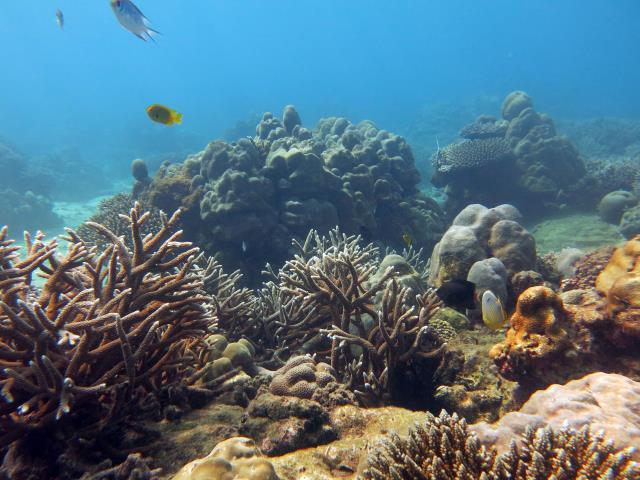
by Julie Freydlin Wednesday, April 8, 2015

This recovering coral reef in the Seychelles is dominated by structurally complex Acropora and Porites corals, which provide shelter for fish and other organisms. Credit: Nicholas Graham
Ocean temperatures that rise too much or for too long can harm coral reefs, sometimes causing mass die-offs that leave reefs nearly barren of live corals. But scientists don’t know if or under what conditions reefs — which provide habitat for a wide array of marine species, as well as food for millions of people around the world — can recover from such catastrophes, in part because of a lack of long-term studies tracking damaged reefs. Now, a new study suggests that, given time and the right conditions, even once-decimated reefs can recoup their losses.
Scientists collected data from 21 reefs in the Seychelles archipelago, located about 1,500 kilometers off the East African coast, on five occasions over a 17-year-period from 1994 through 2011. In 1998, temperature oscillations related to internal variability within the Indian Ocean, combined with the strong El Niño event that year, led to above-normal ocean temperatures lasting for weeks.
When waters warm, corals expel the photosynthetic algae that normally live symbiotically within the corals. Algae lend corals their beautiful colors — and provide food for the corals through photosynthesis — so if warming is severe and much or all of these algae are expelled, reefs are left “bleached” white and starving. The warming event in 1998 was so severe that more than 90 percent of the live coral cover on the Seychelles reefs was bleached and died.
A degraded reef in the Seychelles that was taken over by Sargassum seaweed following a major coral bleaching event in 1998. Credit: Nicholas Graham
Yet, in the new study, researchers found that corals on 12 of the 21 reefs studied had begun recovering within about a decade after the 1998 mass bleaching. The rate of coral regrowth on the recovering reefs was slow for the first seven to 10 years, they found, but it increased rapidly after that. “Once enough coral has built up in a site, a greater number of offspring are produced, which accelerates recovery,” says Nicholas Graham, a coral reef ecologist at James Cook University in Australia and lead author of the study in Nature. By 2011, coral cover on the 12 recovering reefs was comparable to coverage in 1994. Coral colonies on the other nine reefs, however, did not recover and the reefs were overrun by seaweed.
By analyzing commonalities among the reefs to explain the pattern of recovery, Graham and his colleagues identified five traits shared by the reefs that bounced back. For one, reefs with an abundance of herbivorous fish were more likely to recover. “Herbivorous fish feed on [seaweed],” Graham says, and when seaweed is cropped, “corals gain a competitive advantage in their war of space.” Similarly, reefs inhabited by abundant juvenile corals were also likely to recover. On the other hand, reefs located in water with high levels of nitrogen, a key nutrient for plant life, were more likely to succumb to seaweed. “A main difference between corals and seaweeds,” Graham explains, “is that seaweeds can rapidly uptake the available nutrients in the water and can grow much faster than the surrounding corals.”
But two factors in particular appeared to most influence whether corals recovered: the depth of the reefs, and whether they had complex structures before being disturbed. Reefs beneath more than 6.6 meters of water fared better, the team reported, possibly because of decreased light penetration in deeper water, which inhibits seaweed growth. And, “the more complex the reef, the greater diversity and abundance of associated organisms,” Graham says. “A highly complex reef structure is likely to maintain important reef processes through the bleaching event and encourage recovery.” In model simulations of reef behavior following the bleaching event, these two factors alone allowed the researchers to correctly predict whether a reef would recover or not 98 percent of the time.
Other factors considered in the study did not seem to matter for reef recovery, including whether or not the reefs were located within “no-take” marine reserves. However, the researchers wrote that such reserves may play a part in coral recovery in areas where herbivorous fish are more heavily exploited than they are in the Seychelles.
Corals are bound to face more bleaching events in the future as global climate continues to warm, but the new study offers hope, says Mark Eakin, coordinator of the National Oceanic and Atmospheric Administration’s Coral Reef Watch program. Because the study identifies what makes reefs more likely to recover after a bleaching event, it should help policymakers and marine planners decide which reefs are “the ones most in need of protection during the period of recovery,” Eakin says. Graham says that reefs could also be saved by implementing policies that increase the number of herbivorous fish and reduce nitrogen-heavy nutrients in the vicinity of reefs, and also that guard against “damage to the physical structure of the reef.”
With or without human intervention, however, reef ecosystems are likely headed for change amid the changing climate. “The reefs of the future are going to look quite different,” Graham says. “While some reefs may continue to bounce back, at least in the short- to medium-term future, there will be winners and losers among species and the community compositions will be quite altered.”
© 2008-2021. All rights reserved. Any copying, redistribution or retransmission of any of the contents of this service without the expressed written permission of the American Geosciences Institute is expressly prohibited. Click here for all copyright requests.